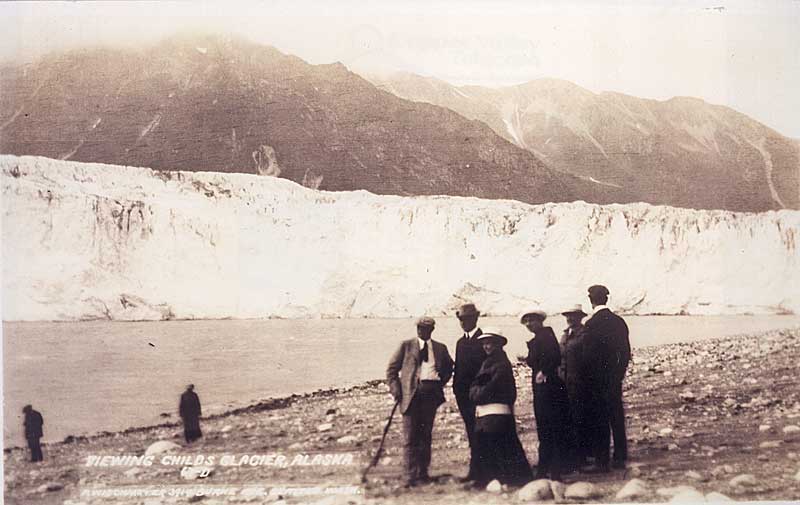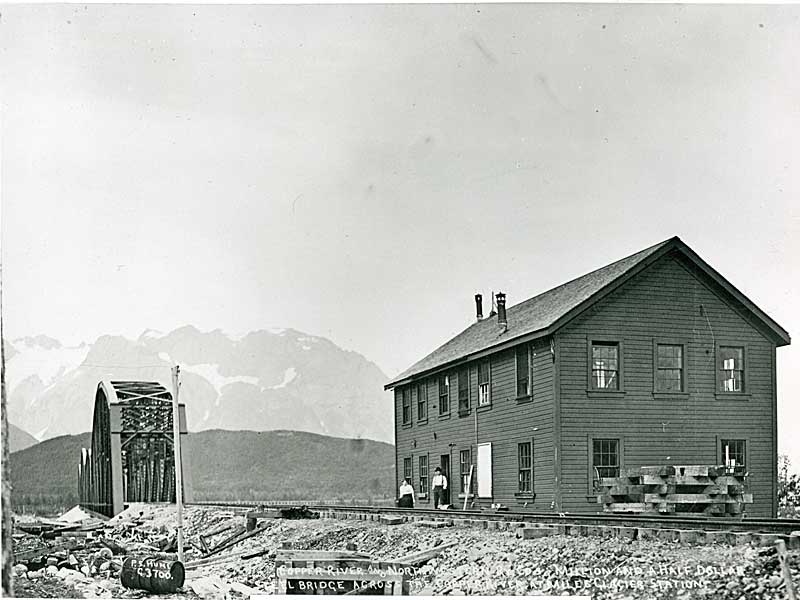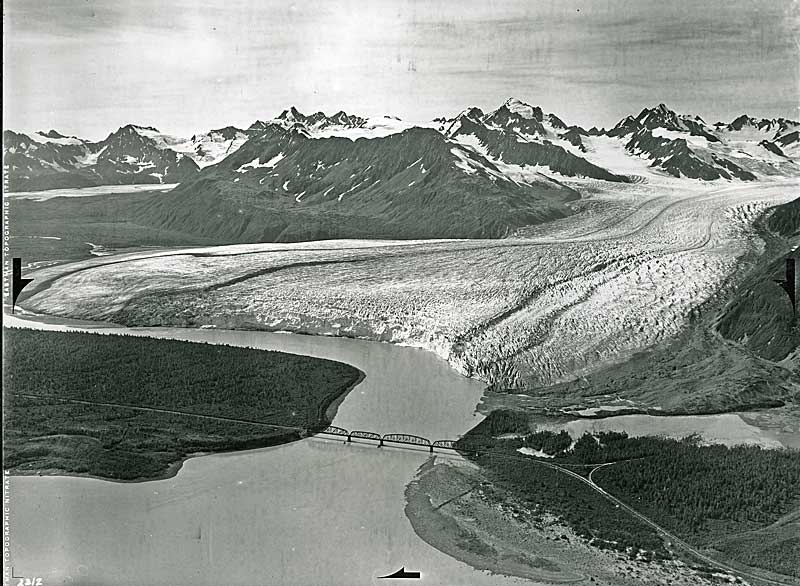The 1,500-foot bridge contained four spans and headed in a northerly
direction, cutting a path between the nearby Childs Glacier to the west
and the more distant Miles Glacier beyond iceberg-filled Miles Lake to
the east. Miles Lake discharged a constant barrage of these icebergs
which calved off the distant glacier. These floated toward the bridge,
some of them sticking out of the water as much as twenty feet and often
striking the concrete icebreakers just upstream from the bridge. Other
pieces hit the bridge piers directly at up to twelve miles per hour
before entering the main channel under the 450-foot third span of the
bridge. Everything then flowed toward the 300-foot tall ice wall that
was Childs Glacier.
Because of its relatively close distance to the bridge, Childs Glacier
appeared to be the larger of the two. It was barely more than a
bridge-length away from the bridge itself. In reality, Miles was about
twice the size of Childs. The Copper River entered the ice-choked lake
from the north at a point about midway between the two glaciers. The
river undercut both glacier toes, causing glacial calving which was
spectacular to behold. The ice blocks which fell off weighed as much as
ten tons and caused tremendous waves. This is most noticeable at the
nearby Childs Glacier, where the falling ice sent huge waves of water
across the river in the direction of the river bank below the bridge. It
frequently beached the migrating salmon, attracting bears which had
found the glacial calving to result in a ready source of easy meals.
Those waves also threw up tons of sand, gravel and boulders. It was not
prudent to stand too close to the east bank of the river opposite the
face of Childs Glacier.
 |
Childs Glacier
calving. --Simpson Files |
|
 |
Tourists at Childs Glacier --Candy
Waugaman collection |
Special No. 74 pulled short of the Million Dollar Bridge, stopping on
the south end, enabling the passengers to leave the train for a close-up
view of the glaciers. Mary chose to stay in the private club car. She,
like the others, was amazed at the beauty and massiveness of the 300
foot tall Childs Glacier with its thousands of feet of wall face, but
had no desire to step out into the wilderness which lay just beyond the
tracks. Even so, wild Alaska has its own way of taming even the most
jaded of its visitors. Mary could only gaze on at this spectacle in a
state of stunned disbelief and awe. At last she was beginning to
understand the attraction which this wild territory held for the great
men of action such as her husband.
|
I never imagined the greatness of this part of Stephen’s world.
It truly is magnificent. The work it must have taken to bring
this train way out here truly has to be a wonder. This really is
a superb, scenic train ride, so much more spectacular than the
Great Northern. He was right about that.
I have to admit, if only to myself, there really is something to
this Alaska. I had to see it for myself to believe it. Here I
am, further away from culture than I could have ever dreamed,
yet I’m actually enjoying this. At least I will allow
myself to enjoy it for a few minutes. This reminds me of the
cruise through the Southeast waters. I’d never admit my sense of
awe and wonder to Stephen, though. He might think I’m slipping.
| |
The car rocked as a gust coming down the canyon caught the car directly
on its long side. It was followed by an even larger gust that came
blasting through the area. The warmth of the car shielded Mary from the
iciness of the wind gusts.
 |
Million Dollar Bridge --E.B.
Schrock, 84-80-15N, UAF AK & Polar Regions archives |
|
 |
Bradford Washburn aerial photo of the
Million Dollar Bridge looking west toward Childs Glacier and
showng the RR wye on the north side of the bridge. |
A Native man, who was dressed in a heavily starched white uniform,
offered her some freshly brewed tea. She graciously accepted. Mary was
beginning to feel ashamed for the way she had treated the help on this
trip.
“My name is Mary Birch.”
“Yes ma’am, I know. I am the cook and sometimes also the waiter. My
young helper is out there with the guests in case any of ladies need
assistance stepping around the large rocks.”
“Are you an Eskimo?”
“No, madam. My people are Ahtna Indians. I’m from the Copper River.
We’re all Indians around here. No Eskimos except maybe near Cordova.”
“Oh. I’m sorry. I didn’t know. What is your name?”
“Tom Bell, madam.”
“Tom, it is good to meet you. You have a fine, pleasing smile and I like
your courteous service. Have you worked here long?”
“Almost from the beginning. I like the railroad, ma’am.”
Well, it’s been pleasant chatting with you, Tom. Could you find me some
playing cards?”
“Yes, ma’am.”
He skillfully poured the tea and then quietly departed. She turned in
the other direction toward the east. She was completely alone in the car
now. It was quite a distance across the ice-filled lake to the glacier.
It appeared to be nothing but bright white in that direction as far as
her eyes could see.
|
How unique. The bridge crosses between two glaciers. Where else
on earth . . ? I would never admit this to Stephen, but this is
the country which seems to suit him best. He seems so at peace
and happy out here. Too bad. Instead he’s got a high-bred,
sophisticated city girl. Maybe he should have just stayed up
here and married an Ahtna Indian, or even an Eskimo. Their
simple ways seem to fit him and his humble style only too well.
| |
She quietly chuckled to herself at this piece of divinely tasteless bad
humor. She was beginning to feel better after several days of illness.
|
Except, of course he’s too big for even this country, and far
too arrogant to last long among these Natives. He needs my sense
of taste and style and European culture to fit his ruthless,
insatiable, power-hungry, aggressive nature. Yes, that’s why I
married him. | |
The party had enough of the bone-chilling gusts. The cold wind was
causing some of the men and women to develop ear-aches. They began
re-boarding the train very quickly after that second large gust almost
tore the tied-down large-brimmed hats off of some of the women. The men
were able to retrieve theirs. It looked pleasant out there from the
warmth of the luxury coach, but the winds were most definitely building
up.
Stephen found Mary happily playing poker against Tom Bell while sipping
on some tea. She was even humming to herself. As soon as Stephen entered
the room, Tom stood up and left.
Birch directed the train to move to the wye-siding on the north end of
the bridge, away from the open area over the center of the bridge which
was in the direct path of the wind. The party would enjoy a gourmet
lunch prepared by Tom Bell before proceeding on to Chitina.
Mary looked up at Stephen from her table and smiled for the first time
since they had left Juneau.
“Would you and the guests care for a cup of tea before lunch, dear? The
tea is very hot after those cold winds you must have found out there. In
here it’s simply delightful amid all this spectacular glacial scenery.”
Stephen was taken aback. Maybe this trip could be salvaged after all,
for Mary was finally adjusting. Stephen and his male guests lit cigars
and enjoyed the tea while the cold gusts pounded at the large
plate-glass windows, rocking the coach ever so gently. The guests
relaxed to a full view of a wild Alaskan panorama which would never
again be duplicated once the Copper River and Northwestern Railway ended
its relatively brief life. But that was still twenty-two glorious years
away. The greatest days of the railroad and the mines which it served
lay just ahead. Stephen was optimistic The reports he received from
Stannard showed that this had been the best year of copper production
ever. His copper mines had no end in sight.

|
A Childs
Glacier Tourist Train "Photo Special" --UAF,
Frederick Mears, 84-75-387 |
“Gentlemen, a toast. We have carved a copper empire out of this
wilderness. The treasures of Alaska are ours for the taking. Everything
is paid for, including the steamship line, the railroad, the mines and
mill. It’s all profit now. What a glorious future lies ahead for
Kennecott!”
F.A. Hansen and the other men stood up in response. Hansen responded.
“May this, the honeymoon trip of Stephen and Mary be a most memorable
occasion worthy of the great man who has made all of this possible.”
In those early days when everything on the railroad and in the mines was
new and worked well, the general feeling was that Stephen Birch had
indeed created an Alaskan copper empire miracle which would go on
forever. Over a million dollars worth of copper was crossing the docks
at Cordova every month with no end in sight, but the edges of Stephen’s
far-flung empire, built on an old notion which mirrored the general
western attitude which so unthinkingly supported the outdated concept of
American Manifest Destiny, would soon begin to fray, unravel, and
finally crumble.
In the headiness of the moment, every one of the elite members on board
the Kennecott conveniently forgot that the route of the CRNW Railway had
already been rejected as the official railroad to Fairbanks in favor of
a much more antiquated system out of Seward known as the Alaska Central
Railroad. The easy access to the Alaska Syndicate’s Bering River coal
fields, which would have guanateed the relatively inexpensive operation
of the railroad, had similarly been denied. Most significant of all, the
Kennecott engineers were not nearly as optimistic about the longevity of
the mines as were the board of directors.
 |
The
observation car "The Kennecott" in 1916. --Candy
Waugaman Collection |
What looked like a multi-purpose railroad made up of both passengers and
freight with a guaranteed bright future was only an elaborate mining
railroad which dead-ended at the head of what was effectively an
enormous box canyon lined with ice. The railroad ended in the middle of
nowhere along the side of a dying glacier. That’s the way it would
remain, for that was the ultimate fate of the Copper River and
Northwestern Railway that it would never go far beyond the shadow of
Uk’eledi.
|
No comments:
Post a Comment